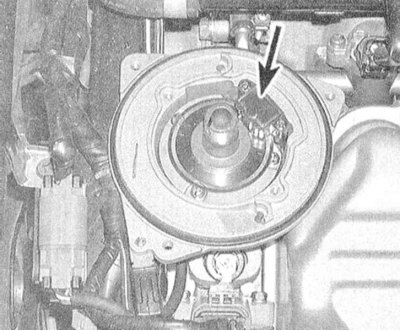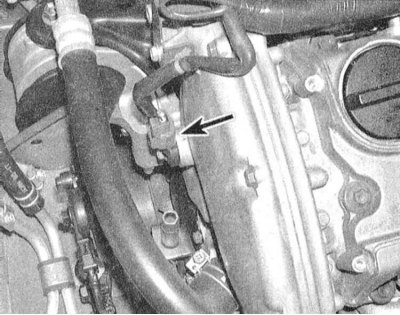Note. Performing the procedure described below may lead to the entry into the OBD memory of a malfunction, which will be highlighted by a control lamp "Check engine". Upon completion of the check and the corresponding remedial repair, do not forget to clear the system memory (see Section On-Board Diagnostic System (OBD) - the principle of operation and fault codes).
Models 1993 and 1994 issue

1. The CMP sensor is used to determine the engine speed and the current position of the pistons in its cylinders. The recorded information is sent to the on-board processor, which, based on its analysis, makes appropriate adjustments to the injection duration and ignition timing settings. The CMP sensor consists of a rotor plate and a circuit forming a wave signal. The rotor plate is divided into grooves for 360 divisions (in 1°increments). The shape and location of the grooves allow you to track the engine speed and the current position of its camshaft. A set of light and photodiodes is built into the shaping circuit. When the teeth of the rotor pass in the gap between the light and the photodiode, a successive interruption of the light beam occurs, which is then converted into a wave-like amplitude signal output to the PCM. The PCM sensor is built into the ignition distributor.
2. Disunite the connector in the wiring harness going to the distributor. Turn on the ignition. Use a voltmeter to probe the terminal of the black and white wire of the connector. If there is no voltage, check the condition of the wiring in the circuit between the ECCS relay and the battery. (don't forget the fuses). Also check the condition of the relay itself and the wiring going from it to the distributor connector (see wiring diagrams at the end of the Chapter Onboard electrical equipment). Using an ohmmeter, check the grounding of the black wire terminal.
3. Turn off the ignition and remove the distributor from the engine (see chapter Engine electrical equipment). Restore the original wiring connection. Connect the positive voltmeter lead to the green/black wire terminal on the back of the connector. Ground the negative probe to ground. Turn on the ignition and start slowly turning the distributor shaft, following the readings of the meter. The following picture should take place: 6 jumps with an amplitude of 5.0 V per shaft revolution against the background of a zero base signal. This test confirms that the 120°signal has been correctly registered.
4. With the ignition off, connect a voltmeter to the green/yellow wire terminal. Turn on the ignition and start slowly rotating the distributor shaft. This time there should be regular 5-volt surges at a frequency of 360 pcs. for one revolution of the shaft. This procedure allows you to verify that the 1°signal is being generated correctly.
5. In case of negative results of the checks described above, the ignition distributor assembly must be replaced (see chapter Engine electrical equipment), - CMP sensor is not subject to individual maintenance.
Models since 1995 vol.

1. The CMP sensor is located in the timing cover at the front of the power unit. The sensor consists of a permanent magnet, a core and a wire winding and is used to determine the grooves in the camshaft sprocket. When the teeth of the sprocket pass near the sensor, the magnetic field surrounding it changes, which, in turn, is converted into a signal voltage output to the PCM. Based on the analysis of the information coming from the sensor, the control module determines the position of the pistons in their cylinders (TDC).
2. Disconnect the wiring from the sensor. Using an ohmmeter, measure the resistance between the two terminals of the sensor connector. At a temperature of 20°C there should be a resistance of 1440 ÷ 1760 Ohm (Hitachi sensor) /2090 ÷ 2550 Ohm (sensor manufactured by Mitsubishi) a defective sensor must be replaced.
3. If the above test is successful, refer to the wiring diagrams (see chapter Onboard electrical equipment) and check the wiring coming from the PCM for signs of open circuits. Check for signs of poor grounding on the harness black wire (use an ohmmeter). If the sensor and wiring are OK, drive the vehicle to a workshop to have the PCM diagnosed and repaired accordingly.